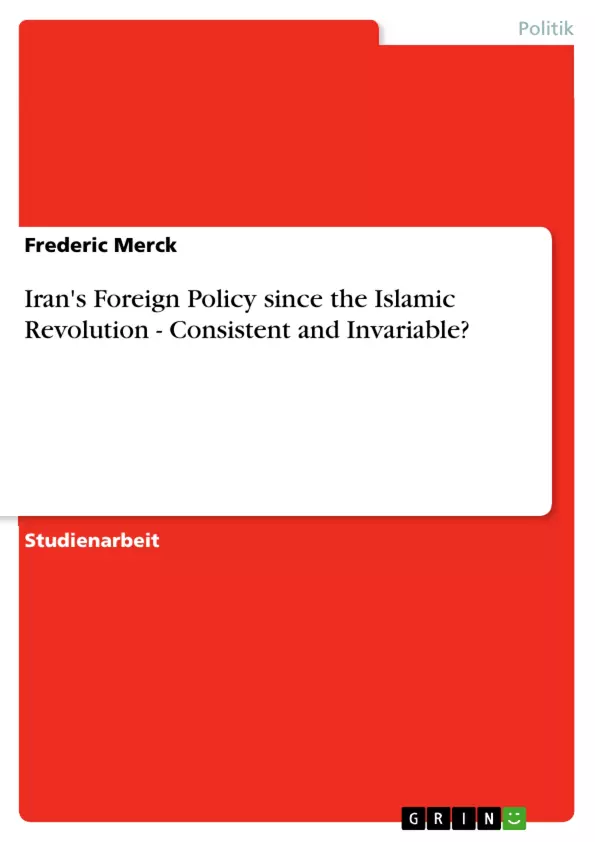[...] Iran is a key player in Middle Eastern politics, especially in the Gulf area, and has been a nemesis of the United States for decades. The Islamic Revolution in 1979 has created a new Iran that, in its roots, accounts for fundamentalist Islamic laws and doctrines, the export of its revolutionary ideology and rejection of western culture or values. But has Iranian foreign policy always been a constant in the country’s history after the Islamic Revolution and immune to change? Has it always been an instrument for the expression of Islamic revolutionary ideas and animosity toward the west? Or did it change significantly during the different political periods? If yes, what were the reasons for those changes? These are the questions and issues this work intends to give answers and explanations to. In this context Iran’s foreign policy agenda in the different periods of Iranian politics will be examined. Also the country’s relations with the Western world, that is the United States and mainly the Western European countries, respectively the European Union, will be emphasized in order to identify the implementations of its foreign policy in practice. Chapter 2 will deal with Iran’s foreign policy under the influence of Ayatollah Khomeini. The period of transition (Chapter 2.1.) and the time of Islamic consolidation and manifestation of the isolation policy (Chapter 2.2.) will be regarded separately. Chapter 3 will analyse the foreign policy of Iran during the presidency of A. H. Rafsanjani and identify a first shift in the policy paradigm. In order to serve this work’s thesis a major part of this work will be dedicated to Chapter 4 which examines the aspects of Iranian foreign policy under Mohammad Khatami, due to their significance in this regard. In each of the mentioned chapters a subchapter will take a closer look at Iran’s relations with the West (Chapters 2.3., 3.2., 4.2.). Despite the fact that scientific research material about the recent election of Mahmoud Ahmadinejad as the new president of Iran and the abovementioned events does not yet exist, chapter 5 will give a comment on this issue out of the composer’s perspective. Eventual Chapter 6 will draw a conclusion and formally give an answer to the work’s main question.
Inhaltsverzeichnis
- Introduction
- Khomeini's Iran: Islamic Foreign Policy
- The Transition Period
- Isolation and "Export of the Revolution"
- Relations with the West
- The Rafsanjani era: Period of Pragmatism
- Iran's foreign policy under Rafsanjani
- Relations with the West
- The Khatami era: Period of Reform
- Iran's foreign policy under Khatami
- Relations with the West
- Iran under Ahmadinejad: Return to Conservatism and Confrontation
Zielsetzung und Themenschwerpunkte
Diese Arbeit untersucht die iranische Außenpolitik seit der Islamischen Revolution im Jahr 1979 und beleuchtet, ob sie in ihrer Ausrichtung konstant geblieben ist oder sich im Laufe der Zeit signifikant verändert hat. Sie beleuchtet die verschiedenen politischen Perioden in Iran und die Rolle der Außenpolitik als Ausdruck islamischer revolutionärer Ideen und der Beziehung zum Westen.
- Die Entwicklung und Kontinuität der iranischen Außenpolitik nach der Islamischen Revolution
- Die Rolle islamischer Ideologie und Werte in der iranischen Außenpolitik
- Die Beziehung Iran zum Westen, insbesondere zu den Vereinigten Staaten und der Europäischen Union
- Die verschiedenen Phasen der iranischen Außenpolitik unter Khomeini, Rafsanjani, Khatami und Ahmadinejad
- Die Auswirkungen von innenpolitischen Veränderungen auf die iranische Außenpolitik
Zusammenfassung der Kapitel
- Kapitel 2: Khomeini's Iran: Islamic foreign policy
- Kapitel 2.1: The Transition Period: Beschreibt die Übergangsphase nach der Islamischen Revolution, die Gründung der Islamischen Republik und die Einführung einer Politik der Nicht-Alligkeit unter Mehdi Bazargan.
- Kapitel 2.2: Isolation and "Export of the Revolution": Analysiert die Phase der Isolierung und der Verbreitung der revolutionären Ideologie unter Khomeini.
- Kapitel 2.3: Relations with the West: Untersucht die Beziehungen Iran zum Westen während der Zeit Khomeinis, insbesondere die Geiselnahme amerikanischer Diplomaten.
- Kapitel 3: The Rafsanjani era: Period of Pragmatism
- Kapitel 3.1: Iran's foreign policy under Rafsanjani: Beschreibt die pragmatischen Veränderungen in der iranischen Außenpolitik während der Präsidentschaft von Akbar Hashemi Rafsanjani.
- Kapitel 3.2: Relations with the West: Untersucht die Beziehungen Iran zum Westen während der Zeit Rafsanjanis.
- Kapitel 4: The Khatami era: Period of Reform
- Kapitel 4.1: Iran's foreign policy under Khatami: Analysiert die Reformen in der iranischen Außenpolitik unter Mohammad Khatami.
- Kapitel 4.2: Relations with the West: Beleuchtet die Beziehungen Iran zum Westen während der Zeit Khatamis.
- Kapitel 5: Iran under Ahmadinejad: Return to Conservatism and Confrontation: Gibt eine Analyse der iranischen Außenpolitik unter Mahmoud Ahmadinejad, insbesondere in Bezug auf die nukleare Aufrüstung und die Beziehungen zu Israel.
Schlüsselwörter
Islamische Revolution, Iranische Außenpolitik, Nicht-Alligkeit, Islamische Republik, Khomeini, Rafsanjani, Khatami, Ahmadinejad, Westen, Beziehungen zu den Vereinigten Staaten, Beziehungen zur Europäischen Union, Nukleare Aufrüstung, Israel, Holocaust.
- Citar trabajo
- Frederic Merck (Autor), 2006, Iran's Foreign Policy since the Islamic Revolution - Consistent and Invariable?, Múnich, GRIN Verlag, https://www.grin.com/document/67810



